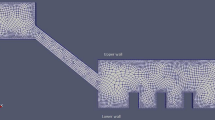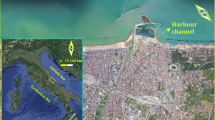Abstract
Spatial dimensions of bedforms relative to the flow depth are of great interest for both engineers and geoscientists, and continue to be an active area of research. These morphological features are of significant consequence for critical hydrodynamic parameters, which in turn has an impact on sediment and solute transport through the river system. In this study, we present results from three-dimensional large eddy simulation of flows over such bedforms in a straight channel. Rigid three-dimensional pool–riffle structures occupying the full span of the channel were considered as the macro-bedforms. The presence of pool–riffle affects the spatial heterogeneity of the flow parameters such as lateral flow concentration. We observed that the lateral flow concentration increases in convective deceleration (CDF) zone with peak values at the central plane in channels with narrower span. The peak values shift from the central plane towards sidewall in channels with larger width. Flow recovery is found to be faster in narrower channels in the conducted simulations. High-magnitude counter-rotating vortices (HCRVs) in CDF and pool transport the momentum of the flow towards the centre of the channel. Larger channel width ensures persistent presence of HCRV in CDF and pool. Longer riffle length in the streamwise direction is observed to further alter the lateral flow concentration compared to the shorter riffles. Instantaneous bed shear stress mapping reveals the presence of coherent high- and low-velocity streaks on riffles. The coherence of these structures is lost in CDF and pool accompanied with an increase in turbulence represented by an increase in turbulent kinetic energy and Reynolds stress.












Similar content being viewed by others
References
Best JL (1996) The fluid dynamics of small-scale alluvial bedforms. In: Carling PA, Dawson MR (eds) Advances in fluvial dynamics and stratigraphy. Wiley, Hoboken, pp 67–125
Booker DJ, Sear DA, Payne AJ (2001) Modelling three-dimensional flow structures and patterns of boundary shear stress in a natural pool–riffle sequence. Earth Surf Process Landf 26(5):553–576
Carling PA (1991) An appraisal of the velocity-reversal hypothesis for stable pool–riffle sequences in the River Severn. Earth Surf Process Landf 13:355–367
Dashtpeyma H, MacVicar B (2018) Vortex-resistance hypothesis: large eddy simulation of turbulent flow in isolated pool–riffle units. E3S Web Conf 40:05029
de Almeida GAM, Rodríguez JF (2011) Understanding pool–riffle dynamics through continuous morphological simulations. Water Resour Res 47(1):W01502
Dury GH (1970) A re-survey of part of the Hawkesbury River, New South Wales, after one hundred years. Aust Geol Stud 8:121–132
Hassan M, Woodsmith RD (2004) Bedload transport in an obstruction-formed pool in a forest gravelbed stream. Geomorphology 58:203–221
Henderson FM (1966) Open channel flow. Macmillan, New York
Jackson JR, Pasternack GB, Wheaton JM (2015) Virtual manipulation of topography to test potential pool–riffle maintenance mechanisms. Geomorphology 228:617–627. https://doi.org/10.1016/j.geomorph.2014.10.016
Keller EA (1971) Areal sorting of bed material: the hypothesis of velocity reversal. Geol Soc Am Bull 82:753–756
Keylock CJ, Constantinescu G, Hardy RJ (2012) The application of computational fluid dynamics to natural river channels: eddy resolving versus mean flow approaches. Geomorphology 179:1–20. https://doi.org/10.1016/j.geomorph.2012.09.006
Kim SE (2004) Large eddy simulation using unstructured meshes and dynamic subgrid-scale turbulence models. Technical report AIAA-2004-2548, 34th fluid dynamics conference and exhibit
Kleinhans MG (2002) Sorting out sand and gravel: sediment transport and deposition in sand-gravel Bed Rivers. Netherlands geographical studies, vol 293. Royal Dutch Geographical Society, Utrecht
MacVicar BJ, Best J (2013) A flume experiment on the effect of channel width on the perturbation and recovery of flow in straight pools and riffles with smooth boundaries. J Geophys Res Earth Surf 118(3):1850–1863
MacVicar BJ, Rennie CD (2012) Flow and turbulence redistribution in a straight artificial pool. Water Resour Res 48(2):W02503
MacVicar BJ, Roy AG (2007) Hydrodynamics of a forced riffle pool in a gravel bed river: 1—mean velocity and turbulence intensity. Water Resour Res 43(12):W12401
MacVicar B, Obach L (2015) Shear stress and hydrodynamic recovery over bedforms of different lengths in a straight channel. J Hydraul Eng. https://doi.org/10.1061/(ASCE)HY.1943-7900.0001043
MacWilliams MLJ, Wheaton JM, Pasternack GB, Street RL, Kitanidis PK (2006) Flow convergence routing hypothesis for pool riffle maintenance in alluvial rivers. Water Resour. Res. 42:W10427. https://doi.org/10.1029/2005WR004391
Milan DJ (2013) Sediment routing hypothesis for pool–riffle maintenance. Earth Surf Process Landf 38:1623–1641
Nelson JM, McLean SR, Wolfe SR (1993) Mean flow and turbulence fields over two-dimensional bed forms. Water Resour Res 29(12):3935–3953
Nezu I, Nakagawa H (1993) Turbulence in open-channel flows. A.A. Balkema, Rotterdam
Pasternack GB, Bounrisavong MK, Parikh KK (2008) Backwater control on riffle-pool hydraulics, fish habitat quality, and sediment transport regime in gravel-bed rivers. J Hydrol 357(1–2):125–139
Sear DA (1996) Sediment transport processes in pool–riffle sequences. Earth Surf Process Landf 21:241–262
Sinha S, Hardy RJ, Blois G, Best JL, Sambrook-Smith GH (2017) A numerical investigation into the importance of bed permeability on determining flow structures over river dunes. Water Resour Res. https://doi.org/10.1002/2016WR019662
Song T, Graf WH (1994) Non-uniform open channel flow over a rough bed. J Hydrosci Hydraul Eng 12(1):1–25
Stoesser T, Braun C, Gracίa-Villalba M, Rodi W (2008) Turbulence structures in flow over two-dimensional dunes. J Hydraul Eng 134(1):42–55
Stoesser T, Kara S, MacVicar BJ, Best JL (2010) Turbulent flow over a mildly sloped pool–riffle sequence. In: Riverflow—international conference on fluvial hydraulics: Braunschweig, Germany, pp 163–168
Thibodeaux LJ, Boyle JD (1986) Bedform-generated convective transport in bottom sediment. Nature 325:341–343
Thompson DM, Wohl EE, Jarrett RD (1999) Velocity reversals and sediment sorting in pools and riffles controlled by channel constrictions. Geomorphology 27:229–241
Thompson DM (2006) The role of vortex shedding in the scour of pools. Adv Water Resourc 29(2):121–129
Wilkinson SN, Keller RJ, Rutherford I (2004) Phase-shifts in shear stress as an explanation for the maintenance of pool–riffle sequences. Earth Surf Landf 29:737–753
Acknowledgements
We sincerely thank our anonymous reviewer and Bruce MacVicar for their invaluable comments and suggestions that helped in improving our manuscript.
Author information
Authors and Affiliations
Corresponding author
Additional information
Publisher's Note
Springer Nature remains neutral with regard to jurisdictional claims in published maps and institutional affiliations.
Rights and permissions
About this article
Cite this article
Tokyay, T., Sinha, S. Channel width, bedform length and turbulence: numerical investigation of flow dynamics over laboratory-scale pool–riffle sequences. Environ Fluid Mech 20, 819–842 (2020). https://doi.org/10.1007/s10652-019-09724-7
Received:
Accepted:
Published:
Issue Date:
DOI: https://doi.org/10.1007/s10652-019-09724-7




